
 |
|
|
|
1935's Dante's Inferno was produced by the old Fox Films and distributed by the new 20th Century Fox Film Corporation. It plays like a weird piece of delirium tossed into the middle of the Depression years. Most Fox films were fairly small in scope but this one is a grandiose financial gamble on the order of 1930's Just Imagine (a comedy space voyage to Mars). Fox's 1927 Sunrise had been a triumph of European craftsmanship plunked down in West L.A., with enormous sets and artful stylization. Even discounting some of the publicity claims, this Dante's Inferno was a giant production. Its director is Harry Lachman, a noted post-Impressionist French painter who got into films through American director Rex Ingram. With a credits list over-weighted in favor of art directors and special effects wizards, the rather confused morality tale is overpowered by a series of extravagant fantasy and disaster sequences. Big stars Spencer Tracy and Claire Trevor are on hand, along with a special dancing appearance by a young talent who in a few years would herself become a major star -- Rita Hayworth. 1 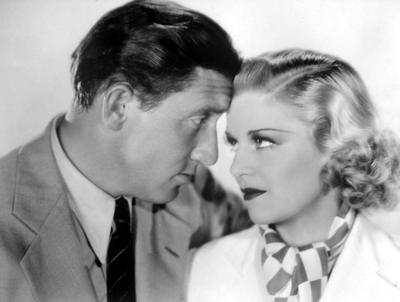
Ocean liner stoker Jim Carter (Spencer Tracy) makes himself unpopular by shirking work and chiseling money from his fellow stokers. Set ashore in New York, he gravitates toward a fun pier and becomes a barker for 'Dante's Inferno', a moralistic sideshow in which kindly owner Pop McWade (Henry B. Walthall) delivers sermon-like speeches about the Poet's nine circles of Hell. Jim's sensational barking brings in the trade, and in no time at all he 'puts Hell on a paying basis'. He marries Pop's daughter Betty (Claire Trevor) and uses the savings of other pier concessionaires to rebuild 'Dante's Inferno' as a massive attraction. Crooked gambling wheel operator Jonesy (Alan Dinehart) becomes his partner and together they push water slide promoter Dean (Robert Gleckler) aside to take away his lease. Jim soon owns the whole pier as well as clubs and attractions elsewhere in town. He dotes on his young son Alexander (Scott Beckett) but lies to Betty whenever the subject of business ethics arises. Determined to stop paying protection money on his illegal casino, Jim stretches his finances to buy a luxury gambling ship that will operate outside the 12-mile limit. But he first must bribe a safety inspector to avoid paying $50,000 on improvements to Dante's Inferno... In Pops McWade's lecture the lesson of Dante's Inferno is that by our actions we all create Heaven or Hell here on Earth. Jim Carter is an unscrupulous opportunist who will do what it takes to achieve his goals, and that includes lying to his wife, ignoring the advice of his saintly Father-in-law, cheating good men of their livelihood, breaking the law and risking the safety of thousands. Taken at face value, the movie is anti-business all the way. 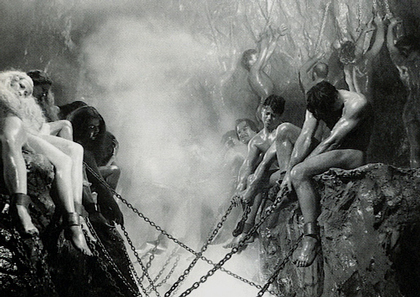
But viewers aren't likely to expend much thought on the surface story, which almost plays as padding between one weird vision and the next. Dante's Inferno is a really disaster film topped by a spectacular fantasy vision of Hell. Pops' first sideshow venue is an impressively art-directed museum of horrors, with devils and gargoyles sculpted into the walls. As the docent, Pops leads visitors from one classical painting to the next, explaining the evil that men do through the stories of Cleopatra, Salomé, and Alexander the Great. Jim immediately identifies with Alexander, and names his son after him. Just as in the story of the Gordian Knot, when Jim is after something he doesn't play games. The premiere of the enlarged Inferno attraction is a huge event, in a large building dominated by a sculpture of a demon. Visitors enter through its grimacing mouth, like 'Moloch' and the workers in Metropolis. Dante's nine circles are represented by nine levels penetrating into a deep pit, with smoke and fire at the bottom. Subverting Pops McWade's humanist messages, Jim introduces scantily clad actresses playing his historical temptresses (too bad this is not a pre-Code picture), followed by The Devil, represented by a giant horned muscleman in a loincloth. Ray 'Crash' Corrigan plays one devil, and another is played by Noble Johnson. 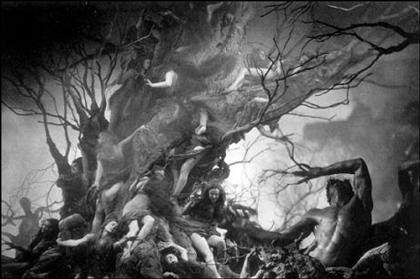
Jim's spectacle goes haywire when the Inferno attraction collapses, imposing a real Hell on the sideshow Hell. This prompts the injured Pops to personally take Jim through his book of Dante, illustrated with pictures in the style of Gustave Doré. The book dissolves to an extended musical set piece visualizing a classic interpretation of Hell. We see the damned escorted into a rocky, smoky region of fire. As in the famous illustrations, they are chained and encased in trees; some have branches growing out of their hands. All writhe in agony. As illustrated on the poster art, the condemned struggle to raise stone lids from their own graves, which seem to be connected to subterranean ovens. Massed groups of the damned try to push large boulders up a hill, Sisyphus-style. I once thought that the Inferno dream sequence had been lifted from a silent film, perhaps an Italian import, but the sequence looks very consistent in quality, and stylistically all of a piece. 2 The camera tracks through enormous miniatures of underground caves, while fire and smoke artfully complete the illusion. At least ten very large sets are filled with perhaps a hundred semi-naked extras. The illusion is so good that plenty of them seem very close to hot lights and fire. The art directors went crazy on this one, as did the optical effects people, superimposing flames and debris to make it look as though sinners are being incinerated wholesale. Seeing a lot of use is the same matting process famously used in King Kong. The shots of people scrambling for protection are beautifully designed, but many human figures turn semi-invisible, showing up the limitations of the early optical work. 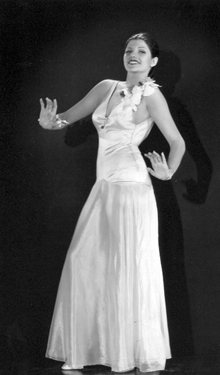
The final action scene Although nowhere near as goofy as C.B. DeMille's Madame Satan, Harry Lachman's Dante's Inferno certainly displays the same streak of apocalyptic hysteria. Jim Carter's unprincipled greed is something anybody can understand, as we see it every day on the news - in too many aspects of modern living, making money is prioritized above the needs of people. Sharp businessman Carter bulldozes a man that stands in his way, bribes another and never pays back the seed money he's taken from his friends. Yet the movie lets him off the hook because "he's learned his lesson." I think Jim Carter would more likely be spending ten years in prison. Rita Hayworth's dancing is seen in an impressive number on the gambling ship. At the time she was still billed as Rita Cansino. Her graceful moves are recognizable from later musicals, even if her makeup and hair have not yet been re-sculpted into the 'Gilda' image. 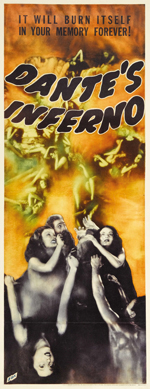
In a way Dante's Inferno is a continuance of the high-art style of Rex Ingram, a producer-director who went to France in the '20s in search of a more conducive filming atmosphere. Not only did director Harry Lachman graduate from Ingram's studio setup in Nice, one of Ingram's MGM silents called The Magician had a bizarre dream sequence where a young woman is given a tour of the underworld. A dancer named 'Stowitz' made a big impression in this sequence, posing practically naked as the pagan god Pan. As Hubert I. Stowitz, this same fellow is credited as a technical advisor on Dante's Inferno as well. The 20th Century Fox Cinema Archives DVD of Dante's Inferno is a very good encoding of this oddity from the 1930s. It appears to be uncut and intact. The quality starts out very high and then pulls back to a slightly less optimum level, but is always better than acceptable. We see grain in the complex optical sequences -- how some of these shots were done is not always clear -- but Fox's disc is the first time I got a good look at everything, including Rita Hayworth. We're told that this was Spencer Tracy's last film for Fox before relocating to MGM. He hated the project and did not get along well with the studio. In a weird turn of events, the film has no actor credits in the main titles, and original posters and lobby cards for the pictures said little beyond 'Dante's Inferno', even though Spencer Tracy was by this time an established star.
On a scale of Excellent, Good, Fair, and Poor,
Dante's Inferno rates:
Footnotes:
1. Fox did make a silent Dante's Inferno with Ralph Lewis in 1924. Its storyline about an irresponsible slumlord doesn't appear to resemble the Spencer Tracy version.
2. A new book source claims that some 'hell' footage was recycled from the 1924 version. Comparing the stills of both versions doesn't make them look very similar in style. But the author Jeremy Bond has presumably seen them for himself, or has his information on good authority.
Reviews on the Savant main site have additional credits information and are often updated and annotated with reader input and graphics. T'was Ever Thus.
Review Staff | About DVD Talk | Newsletter Subscribe | Join DVD Talk Forum |
| ||||||||||||||||||